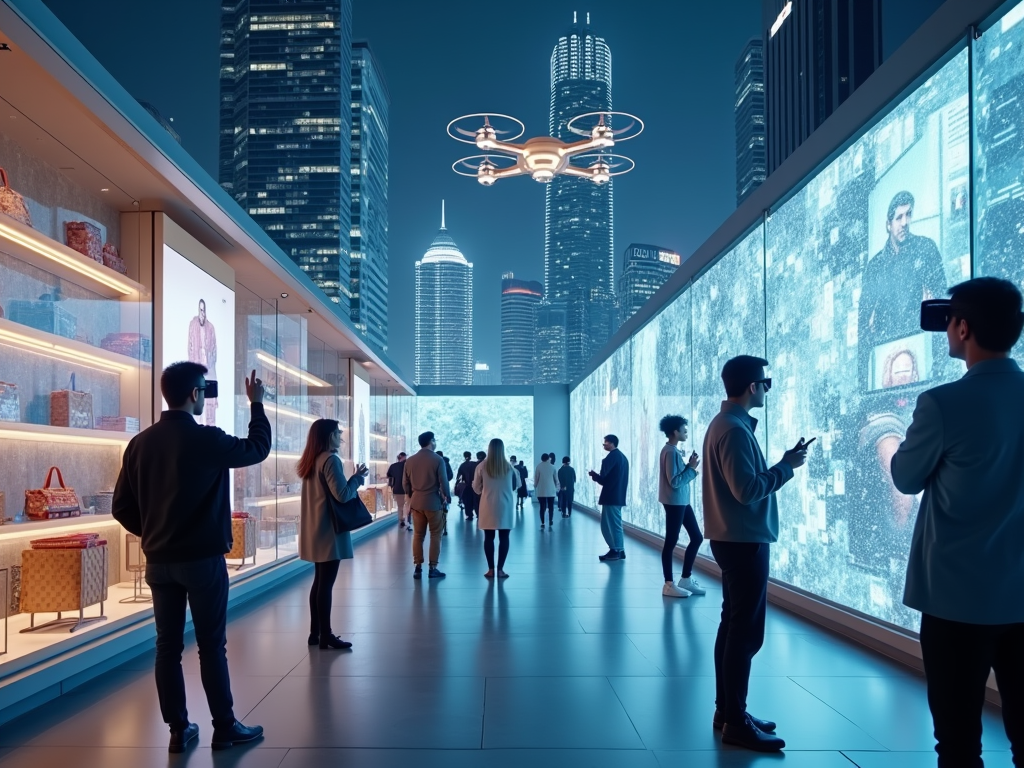The ecommerce industry is changing fast, thanks to new advancements in artificial intelligence (AI) and the increasing demand for more personalized shopping experiences. These technologies are improving how businesses connect with their customers and are changing the way online shopping works. With AI tools, companies can recommend products that fit each shopper’s preferences, manage stock better, and make deliveries smoother, all while meeting customer expectations more effectively than ever before.
At the center of this change is the way businesses use data to understand what shoppers like, need, and want. This helps them offer experiences that feel personal and made just for each customer, building stronger connections and trust. These new ideas are making shopping more satisfying for customers and pushing businesses to update how they work, try new technologies, and find fresh ways to succeed in the fast-moving world of online shopping.
FAQ
Does ecommerce have a future?
What is the future of ecommerce in the next 5 to 10 years?
What technology will dominate online retail?
How will AI transform shopping experiences?
What role will VR play in digital commerce?
How will mobile shopping evolve?
What payment methods will emerge?
How will sustainability impact online retail?
Will social media integrate more with shopping?
Evolution of ecommerce platforms
Ecommerce platforms have changed a lot over time. They now offer more features and work better for both businesses and shoppers. Let’s look at two big shifts in how these platforms have grown.
The shift to headless ecommerce
Headless ecommerce splits the front-end (what customers see) from the back-end (where data is stored). This makes websites faster and more flexible. You can change how your store looks without messing up the behind-the-scenes stuff.
With headless systems, you can add new features quickly. Your store can work on phones, tablets, and even smart speakers. It’s easier to try new ideas and keep up with what shoppers want.
Developers like headless ecommerce because they can use different tools for the front-end. This means better-looking stores that load faster. Shoppers get a smoother experience, which can lead to more sales.
Rise of omnichannel retailing
Omnichannel means selling through many channels that all work together. Your online store, physical shop, and social media all connect. This gives shoppers a smooth experience no matter how they buy. With omnichannel, you can start shopping on your phone and finish on your computer. Or you can buy online and pick up in the store. Your shopping information follows you across channels.
Inventory systems now update in real-time across all channels. This means fewer out-of-stock surprises. You can also offer things like in-store returns for online purchases. Omnichannel helps you learn more about your customers. You see how they shop across different channels. This lets you offer better service and more personal deals.
Looking to sell online? Develop and launch your store with 10Web AI Ecommerce Website Builder.
Create your online store in minutes!
The future of ecommerce
Ecommerce is in constant evolution, driven by emerging technologies, changing consumer behaviors, and global trends. To stay ahead, businesses must anticipate and adapt to the innovations shaping the future of ecommerce.
Let’s discuss the key trends and developments that will redefine the future of ecommerce in the coming years.
1. Consumer behavior trends
Shoppers want personalized experiences and easy-to-use websites when buying online. These key factors are shaping how people shop on the internet.
Preference for personalization
Customers expect online stores to know what they like and need. Many sites now use data to show products a shopper might want. You may see suggestions based on past purchases or browsing history. Some stores let you make wish lists or save favorites. This helps them learn what you like.
Personalized emails are common too. You might get messages about sales on items you’ve looked at before. Or reminders about things left in your cart. Smart tech helps stores tailor their offerings to each person.
User experience
A good shopping experience is essential for customer satisfaction and loyalty. Fast-loading, easy-to-navigate websites are critical, allowing users to find products quickly and check out without hassle. Clear product photos and detailed information help shoppers make informed purchasing decisions.
Key features shaping modern user experiences include:
- Mobile optimization: With mobile shopping on the rise, ecommerce sites must work flawlessly on smartphones.
- Convenience features: Options like one-click purchasing simplify the buying process, saving shoppers valuable time.
- Immediate support: Chatbots and virtual assistants provide real-time answers to customer questions, improving overall satisfaction.
- Augmented reality (AR): Some platforms now offer AR tools, enabling users to “try on” clothing or visualize furniture in their homes, bridging the gap between online and in-store experiences.
These innovations aim to make online shopping as intuitive and engaging as browsing in a physical store, ensuring customers return for future purchases.
2. Integration of AI and machine learning
AI and machine learning help stores know what you want. In the future of ecommerce this is going to improve further. They look at what you’ve bought before and suggest things you might like. This makes shopping faster and more personal.
AI chatbots can answer your questions at any time. They help you find products and solve problems quickly. Stores use AI to manage their stock better too. This means they have what you need when you need it. Machine learning helps catch fraud and keep your info safe when you shop online. It spots odd patterns to stop bad guys.
3. Advanced payment gateways
Payment gateways now offer more options than just credit cards. Digital wallets like Apple Pay and Google Pay let shoppers pay quickly with their phones. Some stores take cryptocurrencies like Bitcoin. Buy now, pay later services split big purchases into smaller payments.
These new methods are faster and more convenient. But stores must make sure they work well on mobile devices. Customers expect a smooth checkout on any device. Gateways also need to handle different currencies for global sales.
4. Advanced fraud protection measures
As online shopping grows, so do attempts at fraud. Stores use AI and machine learning to spot fake orders. These systems check things like shipping addresses and buying patterns. They can block suspicious purchases in real-time.
Two-factor authentication adds an extra security step. This might mean entering a code sent to your phone. Biometrics like fingerprints or face scans are becoming more common too. These make it harder for thieves to use stolen card info.
Tokenization replaces card numbers with random codes. This protects customer data if a store gets hacked. 3D Secure adds bank verification to online payments.
5. Mobile commerce
Mobile shopping is taking over ecommerce and will continue so in the future of ecommerce. More people now buy things on their phones than on computers. This shift brings new opportunities and challenges for online sellers.
To succeed in mobile commerce
- You need a website that works well on phones.
- Ensure that your site loads fast and is easy to use on small screens.
- Use big buttons and simple menus.
- Let shoppers save their information for quicker checkout.
- Add features like image search and voice ordering. These make it easier to shop on phones.
Mobile apps can boost sales too. They’re faster than mobile websites and can send alerts about deals. With 5G connectivity, mobile shopping becomes even easier, enabling faster page loads and richer features like high-quality videos, 3D product views, and virtual store experiences, all without lag. This technology also enhances mobile payments and order tracking, making the process more secure and efficient. You can add fun stuff like augmented reality to let people “try on” clothes or see how furniture looks in their homes.
6. Sustainability in ecommerce
Ecommerce businesses are making big changes to protect the planet. They’re using green packaging and finding ways to make products that are better for the environment.
Eco-friendly packaging and shipping
Many online stores now use boxes and mailers made from recycled materials. Some even have packaging that can break down in nature. Amazon and Walmart lead the way with their frustration-free packaging programs. These cut down on waste and make it easier to open packages.
Companies are also trying new ways to ship items. Some use electric trucks or bikes for local deliveries. Others team up to share delivery routes and save fuel. UPS and FedEx now offer carbon-neutral shipping options. This lets shoppers pay a bit extra to offset the carbon from their deliveries.
Sustainable sourcing and manufacturing
More ecommerce brands are looking at where their products come from. They want to make sure workers are treated fairly and paid well. They also try to use materials that don’t harm the planet.
Patagonia is a good example. They use recycled polyester in many clothes. They also fix worn items to keep them out of landfills. Other companies like Everlane show exactly where their clothes are made. This helps shoppers know their stuff comes from good places.
Some brands go further by making products on demand. This cuts down on waste from unsold items. 3D printing is helping with this too. It lets companies make things only when someone buys them.
7. Real-time inventory management
Smart systems now track product levels constantly. This helps stores avoid running out of popular items. When stock gets low, the system automatically orders more.
Barcode scanners and RFID tags make counting inventory quick. Workers can see exactly what’s on hand using mobile devices. Cloud software updates numbers across all sales channels at once.
This real-time view helps stores fulfill orders faster. It also reduces waste from overstocking. Customers see accurate product availability when shopping online.
8. Drone delivery and robotics
Drones and robots are starting to deliver packages. This speeds up shipping, especially to hard-to-reach areas. Some companies now use drones for last-mile delivery in cities. The drones can avoid traffic jams and get to customers quickly. Robots help move items around warehouses too. They can pick products off shelves and pack boxes.
These machines work alongside human workers. They handle repetitive tasks, letting people focus on more complex jobs. As the tech improves, more stores will likely adopt it to stay competitive.
9. Social commerce expansion
Social media platforms are becoming major players in online shopping. Businesses can now sell products directly through social networks, reaching customers where they already spend time. Many social platforms now offer in-app buying options. Instagram lets businesses tag products in posts and stories. Users can tap to view details and purchase without leaving the app. Facebook Shops allows companies to set up free online stores. TikTok is testing features for creators to sell merchandise to fans.
To succeed with social selling, do the following:
- Choose the platforms your target customers use most.
- Post engaging product photos and videos.
- Use shoppable posts to showcase items.
- Respond quickly to comments and questions.
- Track which content drives the most sales.
10. Predictive data analytics in ecommerce
Data and customer insights drive modern ecommerce success. Companies use advanced tools to understand shoppers and boost sales. Predictive analytics helps online stores guess what customers want before they buy. It looks at past purchases, browsing habits, and other data to make smart guesses. This lets shops show products people are likely to want.
Some ways stores use predictive analytics:
- Recommending items based on past buys
- Pricing products to match demand
- Stocking inventory to avoid running out
- Sending personalized emails and ads
These methods can increase sales and keep customers happy. They also help stores run more efficiently by predicting busy times and popular items.
11. Cross-border ecommerce strategies
To reach global markets, you need a solid plan. First, start by picking target countries with high demand for your products. Next, research local laws and taxes to make sure you follow the rules.
Also, consider partnering with local shipping companies to get orders to customers fast. Think about using regional warehouses to cut delivery times. This can boost customer happiness and save you money. Offer payment options that work in each country. Some places prefer cash on delivery, while others like digital wallets. Giving customers familiar ways to pay can increase sales.
12. Localized content and multilingual support
Speaking your customers’ language is key. Translate your website and product info into local languages. But don’t stop at word-for-word translation. Adapt your content to fit local culture and habits.
Use images and examples that make sense to local shoppers. What works in one country might not click in another. Pay attention to colors too, as they can mean different things in different cultures.
Provide customer support in local languages. You can use translation tools or hire native speakers. Quick, clear answers in the right language can turn frustrated customers into loyal fans.
Consider local social media platforms for marketing. While Facebook is big in some countries, others might prefer WeChat or VK. Meeting customers where they already spend time online can help you connect better.
13. Subscription services and D2C
More businesses are using subscription models to keep customers coming back. You sign up to get products sent to you regularly. This works well for things you use often, like razors or pet food. Companies like Dollar Shave Club have found success this way.
Direct-to-consumer (D2C) brands are also on the rise. They make and sell their own products without middlemen. This lets them control quality and build closer ties with buyers. Brands like Warby Parker for glasses and Casper for mattresses use this model.
Both these approaches help companies predict sales and keep customers loyal. They also gather data to improve products and marketing.
Conclusion
The future of ecommerce is exciting and promising. As technology gets smarter and shoppers expect more, businesses should keep up. Trends like personalized shopping, faster mobile experiences, and greener practices are making online shopping easier, more fun, and better for the planet.
It’s not just about selling things anymore—it’s about understanding customers, building trust, and offering real value. Businesses that follow these changes, like using AI to make better recommendations or offering seamless shopping across devices, will stay ahead. The key is to keep improving, listen to what customers want, and try new ideas.
Looking to sell online? Develop and launch your store with 10Web AI Ecommerce Website Builder.
Create your online store in minutes!














